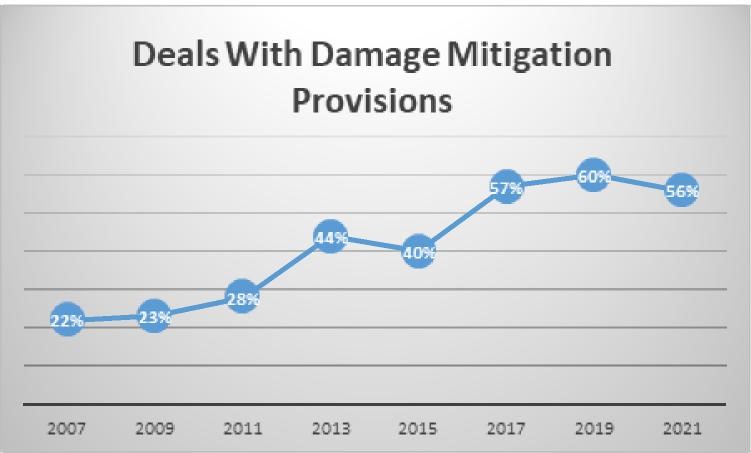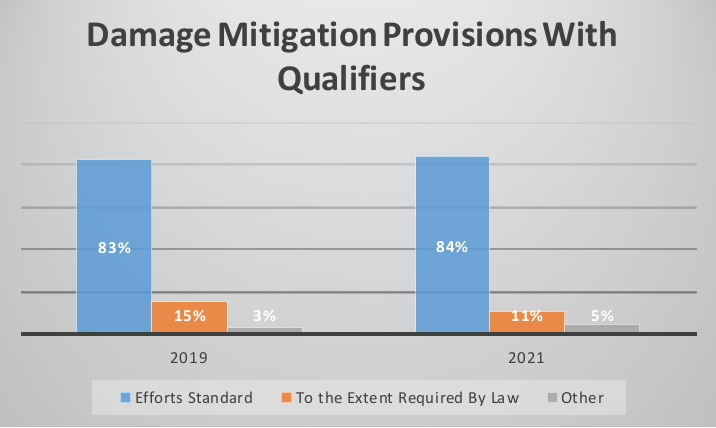Goulston & Storrs M&A attorney Dan Avery is a nationally recognized expert on M&A deal point trends. In partnership with Bloomberg Law, Dan has developed a series of 25 articles looking at these trends, on a topic-by-topic basis, providing practical insight into where these trends are heading, and the relevant implications for M&A deal professionals.
Market Trends: What You Need to Know
As shown in the American Bar Association's Private Target Mergers and Acquisitions Deal Points Studies:
- Inclusion of damage mitigation provisions in merger and acquisition agreements continues to trend upward over the eight ABA studies looking at these provisions (though with a slight dip in the most recent study). Damage mitigation provisions were included in 22% of the deals reported in the 2007 study, as compared to 60% in 2019 and 56% in 2021.
- The 2019 and 2021 studies have also looked at what standard of effort was used within damage mitigation provisions included in reported deals. In those purchase agreements with damage mitigation provisions, 10-15% incorporated a “to the extent required by law” standard; about 85% required a different standard of mitigation effort (e.g., “commercially reasonable efforts” or “best efforts”).
Introduction
In M&A transactions, the definitive purchase agreement (whether asset purchase agreement, stock purchase agreement, or merger agreement) typically contains representations, warranties, and covenants, along with related indemnification obligations. One topic that often comes up for discussion between the seller and the buyer is whether the indemnification obligations should be limited by, or whether the purchase agreement should otherwise contain, an express obligation of the indemnified party to mitigate damages.
Damage Mitigation Provisions
General
The indemnification obligations under an M&A purchase agreement generally pertain to breaches of the representations, warranties, and covenants of the respective parties, but sometimes also apply to other legal or business matters on a standalone basis, regardless of whether such a breach has occurred. A typical M&A purchase agreement includes indemnification from the seller to the buyer, and vice versa.
However, because the seller's representations, warranties, and covenants, and related indemnification obligations, are normally broader in scope and substance than those of the buyer, it is usually the seller who seeks to include damage mitigation. This is because the seller is more likely to be the indemnifying party and therefore more interested in including provisions that reduce indemnification liability, even if the same limitations are applicable to the buyer as well. Accordingly, this article looks at damage mitigation provisions assuming that the seller is more inclined, and the buyer less inclined, to include such provision in the purchase agreement.
A typical indemnification provision may read:
The Seller agrees to and will defend and indemnify the Buyer Parties and save and hold each of them harmless against, and pay on behalf of or reimburse such Buyer Parties for, any Losses which any such Buyer Party may suffer, sustain or become subject to, as a result of, relating to or arising from: (i) any breach by the Seller of any representation or warranty made by the Seller in this Agreement; (ii) any breach of any covenant or agreement by the Seller under this Agreement, (iii) any Taxes of the Seller or its Affiliates; or (iv) the matters set forth on Schedule X.
Damages mitigation provisions may take different forms, including a provision drafted similar to the following:
Indemnitee shall be responsible for taking or causing to be taken all reasonable steps to mitigate its Losses upon and after becoming aware of any event that could reasonably be expected to give rise to Losses that may be indemnifiable under this Agreement.
The negotiation between the buyer and the seller generally focuses on whether the purchase agreement will include an express duty to mitigate or remain silent on the matter. Buyers generally do not ask for a provision that expressly states that the buyer has no duty to mitigate (and while undoubtedly such provisions have been negotiated, the author, in his experience, has not seen such a request).
Similarly, the ABA studies identify whether the reported transactions include an express duty to mitigate or are silent. They do not generally identify express exonerations of the duty (likely because such provisions rarely exist). This is not surprising given that there generally is a duty to mitigate damages under common law contract principles in the absence of an express contractual obligation to do so, as noted below.
The Common Law Duty to Mitigate Damages
It is a general principle of contract law in the U.S. that a party cannot recover damages for losses if those damages could have been reasonably mitigated or avoided. See, e.g., Restatement (Second) of Contracts § 350, cmt. b. (“As a general rule, a party cannot recover damages for loss that he could have avoided by reasonable efforts…. he is expected to take such affirmative steps as are appropriate in the circumstances to avoid loss by making substitute arrangements or otherwise”).
The reference to this as a “duty” is somewhat of a misnomer because the aggrieved party does not incur direct liability for failing to mitigate. Instead, otherwise recoverable losses are simply reduced by amounts that could have been avoided or ameliorated by those mitigation efforts. See also, 22 Am. Jur.2d Damages §355 (“[References to a ‘duty’] are inaccurate expressions of the doctrine of avoidable consequences, however, because, like other principles limiting recoverable damages, the failure to take reasonable action to limit damages does not create affirmative rights in anyone. The only result of such failure is that courts will not allow damages for consequences of an injury that they believe the plaintiff could reasonably have avoided”) (citations omitted).
If a duty to mitigate already exists under well-established contract principles, then why, as we will discuss below, do purchase agreements increasingly include damage mitigation provisions? In that context, aren't such provisions unnecessary?
The Issue Between Buyer and Seller
In the author's experience, there is often little negotiation on this topic even though, as reflected in the ABA studies discussed below, a majority of deals covered by the studies now include duties to mitigate. To many lawyers, the request to include a statement reflecting a buyer's duty to mitigate damages seems innocuous on its face; perhaps not strictly required as a contractual matter given the existing common law duty described above, but what is the harm?
The real issue is whether the parties desire to codify, through the damage mitigation provision, the common law duty to mitigate (or some version of the duty) in clear language that the parties are likely to understand. That damage mitigation provision may or may not exactly mirror the already applicable common law duty to mitigate. The savvy buyer may resist mirroring the common law duty because that duty is already well established and clearly articulated by courts. The buyer could argue that having two separate duties to mitigate—the damage mitigation provision and the common law duty—can create confusion and cause problems interpreting the purchase agreement.
For example, while the common law duty to mitigate simply states that a party cannot recover damages for loss if those damages could have been reasonably mitigated or avoided, a typical damage mitigation provision may obligate the buyer to take “all reasonable steps to mitigate its Losses upon and after becoming aware of any event that could reasonably be expected to give rise to Losses.”
The two duties are different, and arguably the contractual damage mitigation provision is more onerous than the common law duty, because it could be interpreted as creating a duty to act after the indemnified party becomes aware of an event that could reasonably be expected to give rise to damages. Essentially, the damage mitigation provision could be interpreted as creating an affirmative covenant on the part of the indemnitee that, if breached, could result in a direct claim by the indemnitor. This is inconsistent with the common law duty that, as discussed above, does not create an affirmative obligation or duty and for which no liability would attach for failing to act.
Of course, if the seller has enough bargaining power, there is no reason why that seller should not negotiate for a damage mitigation provision that imposes an affirmative mitigation duty that is specific to the transaction and more stringent than the common law duty. While that may seem straightforward, as a practical matter, the parties considering a contractual damage mitigation often are not seeking to create obligations materially different than the existing common law standard, though that may be the unintended result, for the reasons described above.
A seller may argue that this issue is similar to situations where the seller and the buyer agree to define “fraud” in the purchase agreement even though fraud has a common law meaning. However, the situations are not completely analogous because the common law duty to mitigate is well-established and reasonably clear while the definition of common law fraud is more difficult to define in a manner that adequately captures its meaning in all jurisdictions. See West, Glenn D., “That Pesky Little Thing Called Fraud: An Examination of Buyer's Insistence Upon (and Sellers’ Too Ready Acceptance of) Undefined ‘Fraud Carve-Outs’ in Acquisition Agreements,” 69 Bus. Law. 1049 (Aug. 2014). In addition, most definitions of fraud in purchase agreements are narrow in scope, focusing on whether the fraud is “intentional,” “actual,” “constructive” and do not attempt to create a universal definition that captures the common law meaning.
Trends in Damage Mitigation Provisions
Every other year since 2005 the ABA has released its Private Target Mergers and Acquisitions Deal Points Studies. The ABA studies examine purchase agreements of publicly available transactions involving private companies. These transactions range in size but are generally considered as within the “middle market” for M&A transactions; the transaction values of the 123 deals within the 2021 study ranged from $30 to $750 million.
According to the ABA studies, damage mitigation provisions were included in 56% of the deals reported in the 2021 study. This level represents a slight dip to the upward trend witnessed over the previous seven ABA studies that showed inclusion jump from 22% in 2007 to 60% in 2019, as shown by the chart below.

GRAPHIC—Source: ABA Private Target Mergers and Acquisitions Deal Points Studies

In almost all (95%) of the damage mitigation provisions reviewed in the past two ABA studies, the damage mitigation covenant was subject to qualification either by an “efforts standard” (e.g., that the covenant is tied to the damaged party's “commercially reasonable” or other specified efforts to mitigate) or “to the extent required by law.” The chart below shows these recent findings.

GRAPHIC—Source: ABA Private Target Mergers and Acquisitions Deal Points Studies

The concern that contractual damage mitigation provisions may create a standard different than the common law standard independently in effect appears to be confirmed by information in the 2019 and 2021 ABA studies. These two studies looked at what standard of effort was used within damage mitigation provisions included in reported deals. In those purchase agreements with damage mitigation provisions, 10- 15% incorporated a “to the extent required by law” standard; about 85% required a different standard of mitigation effort (e.g., “commercially reasonable efforts” or “best efforts”).
Conclusion
The use of damage mitigation provisions in purchase agreements has increased and, as of the 2017 study, became and has remained the majority approach. Counsel for sellers and buyers should understand and accept that the effect, even if not the purpose, of damage mitigation provisions, is to create an obligation that is likely different than the common law duty to mitigate (unless it simply incorporates or replicates the common law duty). There may be good and rational reasons for modifying the common law rules, but counsel for both sides should carefully assess the reason for and the impact of having two potentially different standards of mitigation applicable to indemnitees.
Click here for a pdf of the article.
Reproduced with permission from Bloomberg Law. Copyright ©️2022 by The Bureau of National Affairs, Inc. (800-372-1033) http://www.bloomberglaw.com.

/Passle/630ddfd8f636e917dcf6e4ce/MediaLibrary/Images/2024-04-10-02-23-24-827-6615f81c7f643c6b40a522fc.png)
/Passle/630ddfd8f636e917dcf6e4ce/SearchServiceImages/2024-03-26-18-33-10-871-660314e6a95774bc3ec2d0f5.jpg)
/Passle/630ddfd8f636e917dcf6e4ce/SearchServiceImages/2024-04-01-19-48-49-062-660b0fa164547688f7bc778e.jpg)
/Passle/630ddfd8f636e917dcf6e4ce/SearchServiceImages/2024-03-28-14-07-08-054-6605798c002b00c29f61ce55.jpg)
